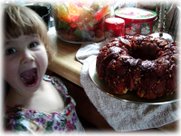The Pasta Experience
As part of my current obsession of making my own pasta dishes, I recently acquired an Imperia pasta machine which arrived on Saturday. Sunday, I promised, would be the day to make our first home-made pasta.
The beauty of pasta is that it requires only two ingredient: flour and eggs. How much more basic can you get than that? The time element to making your own pasta is in the actual rolling and cutting of the dough into noodles. Having a pasta machine is very helpful for this process. While you can make noodles without a machine, using a rolling pin and knives or rolling cutters, the pasta machine makes it much easier. The dough is rolled very, very thin, to the point where you can see the silhouette of your hand through the rolled dough.
You can get more fancy with the ingredients than just the flour and eggs, but it's not necessary. Still, I hope to experiment with some other recipes and techniques, and I'll pass those outcomes on to you as I find them.
The first experiment in The Pasta Experience was to make tagliatelle with alfredo sauce. It took us a long time to make the whole dish, from start to finish. I think the total time was about two hours, and some of that time was spent figuring out how to work the machine and exactly what the dough should feel like. Actually rolling the dough through the machine was not hard at all. My best cooks, which are my two sons, jumped right in to help, and my older son, who is 15, ended up finishing the noodles while I started the sauce. Having an extra hand helps. Even the three year old got into the act, turning the handle to produce long tendrils of fresh noodles. This is a very fun family activity. Make a few appetizers to stave off hunger, whip up your dough, and start rolling! Better than television any day.
So turn off that one-eyed monster. It's time to cook!
Are you ready? Here we go!
))*^*...*^*...*^*(())*^*...*^*...*^*(())*^*...*^*...*^*((
We'll begin with an easy-way-out method, and that's using a food processor to make the dough. If you don't have a food processor, keep your eyes peeled because we'll experiment with hand-mixing the dough.
2 cups of all-purpose flour
3 large eggs, beaten
Ingredients should be at room-temperature before you start, so if you keep your flour in the freezer, like I do, be sure to let it warm up before starting. Start with very fresh eggs, too.
Put your flour in the work-bowl of the food processor, fitted with the steel blade. Pulse it a few times to get the flour all nice and fluffy.
Add the eggs and process the eggs and flour together for about thirty seconds. After thirty seconds, you should see the dough form a rough ball. If it really sticks to the sides of the work bowl, add a bit more flour, little by little, until you get a moist, cohesive dough. On the other hand, if it's too dry and looks like crumbles, add water 1/2 teaspoon at a time until you get the right consistency.
Put the whole mass, including any crumbs or chunks or un-mixed egg, onto a clean work surface and start kneading. It'll be a little tough, not like bread dough, so you're basically just going to keep folding and turning and folding and turning until you get a nice, smooth dough.
Put the dough into a zip-type bag and let it rest anywhere from 15 minutes to 2 hours at room temperature.
Divide the dough into about six or eight pieces, take one out, and put the others back in the baggie. Flatten your piece a bit and lightly coat it with flour on both sides.
If you haven't used your pasta machine before, you'll want to throw this piece out after you run it through. I had to throw out two pieces before the pasta machine ran the dough clean. This is a good chance to experiment with the dough and the pasta machine, so have fun with it.
When it's time to run your first real piece of dough through the machine, start it on the lowest number, which is the widest setting. Fold the dough ends so that the meet in the middle, and then put the piece through the machine again on the widest setting, feeding the open end of the dough through first (not the folded end, but the other end). Run it through the widest setting again, getting a nice, smooth dough. Remember to use flour when the dough gets sticky, but not too much so that you make a tough dough.
Now, each time you run the dough through, narrow the setting until you've run the pasta through the narrowest setting and your dough is very, very thin.
At this point, if the dough is stable enough, you can run the pasta through the cutter attachment. If you want to make all of your dough sheets first and then cut them, stack your sheets of dough between layers of moist, clean kitchen towels. If the dough seems too sticky to cut, let it rest a few minutes before you cut it.
After the dough has been cut, hang it on a rack to dry for about fifteen minutes to cure before boiling it. You can leave the noodles out for up to two hours before cooking, if you need to.
Then, you're ready to make your pasta and sauce!
For excellent instructions with photos and illustrations, see The Complete Book of Pasta and Noodles by Cook's Illustrated and The Pasta Bible by Jeni Wright. Check your local library for other books on pasta, pasta-making and sauce.
Up next, Fresh Egg Noodles with Alfredo Sauce.


No comments:
Post a Comment